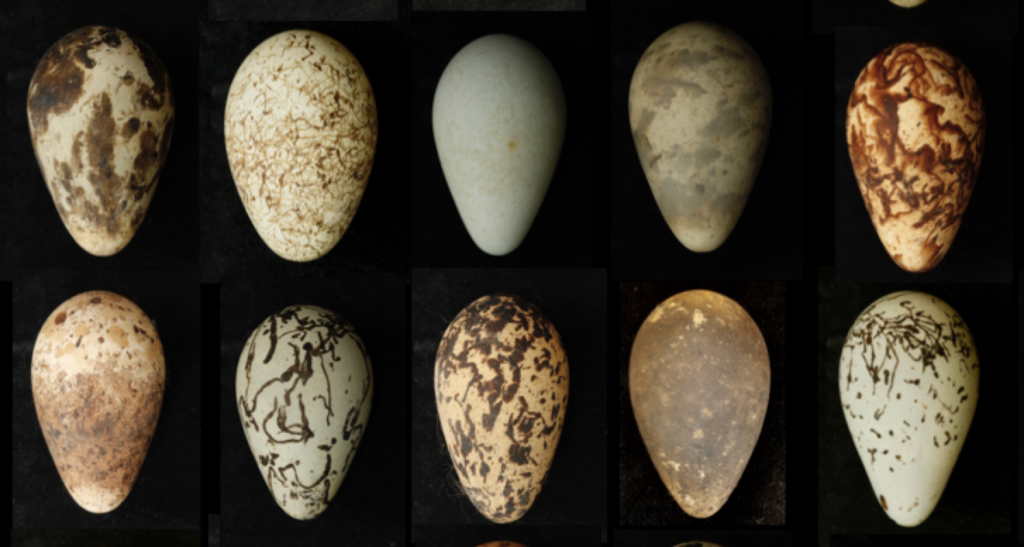By T. R. Birkhead
Linked paper: Exceptional variation in the appearance of Common Murre eggs reveals their potential as identity signals by Tim R. Birkhead; Jamie E. Thompson; Amelia R. Cox; Robert D. Montgomerie. Ornithology.
Few birds lay such spectacular eggs as the Common Murre (Uria aalge; Common Guillemot in Europe). Almost every book on birds’ eggs features a Common Murre egg on its cover or frontispiece—and with good reason due to their distinctive pyriform (pear-like) shape and color variations. The range of ground colors and markings (maculation) on murre eggs are more varied than almost any other bird species; these features, and the fact that they could be obtained in large numbers from breeding colonies, have made murre eggs popular with egg collectors in the past.

At seabird colonies like Bempton, on the Flamborough Headland along coastal northeastern England, or the Farallones off the coast of California, murre eggs were harvested each year for several centuries. Initially, those eggs were intended for human consumption, but once egg collecting—oology—became popular in the 1800s, many of the harvested eggs were bought by collectors. At Bempton, tens of thousands of eggs were taken annually by the ‘climmers’ (Yorkshire for climbers), who descended the 400-foot cliffs on ropes to harvest them.
The commonest ground colors were white, brown, pale blue, or green through to dark green, and decorated with a variety of markings, from tiny speckles, to large blotches, to pencil-like scribbles, or sometimes no markings at all. But with huge numbers to choose from, collectors became discerning, favoring the rarer egg types. These included white eggs with no maculation, those with white ground color with red pencilling, very dark brown eggs, and red eggs (described as being the color of port wine). The variety seemed endless and collectors often commented that no two murre eggs were alike.

The climmers were impoverished labourers from farms adjacent to the cliffs and selling murre eggs was an important addition to their income. They knew where to find rare egg types and bargained hard with collectors for the best prices.
Two questions crop up whenever I talk about murre eggs: How are the colors made? and Why is there so much variation? The first is a mechanistic question and, while we know that the huge range of colors is created mainly by two pigments,biliverdin and protoporphyrin IX, we lack details of how color and maculation are applied to eggs in the oviduct.

Why there is so much variation is a question about adaptation, probably related to the murre’s unusual breeding biology—incubating on open ledges with no nest and at very high densities (typically around 20 pairs per square meter). High-density breeding is how murres protect their eggs and chicks from predatory gulls and corvids. But high-density breeding with no nest comes at the potential cost of misdirected parental care if the eggs of adjacent pairs get mixed up. Individual signatures and the ability to recognize one’s own egg would minimize the risk of misdirected care. Experiments by Beat Tschanz in the 1950s showed that murres usually retrieve their own eggs when they have to make a choice.
What has been missing from this story so far is any rigorous quantification of the color and maculation of murre eggs. This was one of our research team’s objectives while working on Skomer Island off the coast of Wales, between 2016 and 2018. We photographed recently laid eggs in situ and later scored the ground color (hue, saturation, and lightness) and type of maculation (number and roundness). Ground color showed a trimodal distribution, from white (or very pale brown), to pale blue and dark green. Breeding murres are highly site faithful from year to year on Skomer. Thus, by photographing eggs at the same sites over several successive years, we showed that each female’s eggs were similar—but not identical—eggs, in terms of ground color and type of marking. The same was true of replacement eggs, laid after the first egg of the season had been lost.
Our quantitative results confirm the qualitative observations of the Bempton climmers and collectors, that females produce eggs of similar color and markings in successive years. Our other main finding was that, based on the three ledges where we photographed eggs, there were no differences in the colors and markings of eggs between ledges. My long-term population study of murres on Skomer shows that natal philopatry is high among females, suggesting that birds on breeding ledges may be more likely to be related to one another than they are to birds laying their eggs on different ledges. If this is the case, then this level of genetic relatedness among birds breeding on each ledge does not seem to be reflected in the appearance of their eggs.
While Tschanz’s research from the 1950s showed that murres can identify their own egg, we do not know what colors and patterns murres are capable of distinguishing and remembering. Our quantitative results show only that the variation in egg color and markings is sufficient for the Common Murre parents to be able to identify their own egg.
